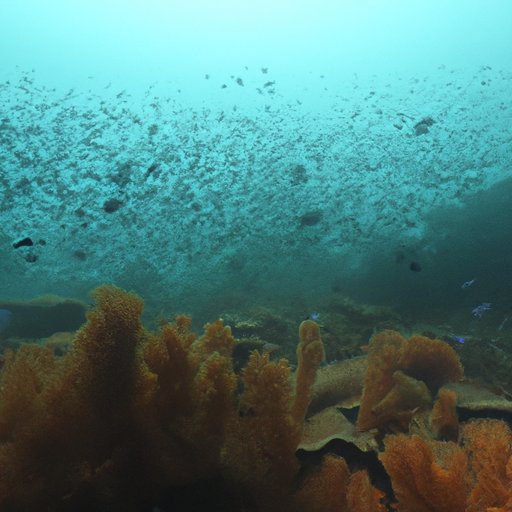Introduction
Have you ever encountered a coral reef while diving or snorkeling? If you have, you may have been awestruck by their beauty and vibrancy. However, coral reefs are facing numerous challenges, such as pollution, overfishing, and climate change. In this article, we aim to provide a comprehensive guide to understanding coral reefs and how to protect them.
The Wonders of the Coral Reef: A Comprehensive Guide to Understanding These Living Structures
Coral reefs are underwater ecosystems composed of calcium carbonate exoskeletons secreted by coral polyps. The exoskeletons are what make up the architecture of a reef, forming a complex maze of crevices, caves, and ledges teeming with marine life.
There are three main types of coral reefs: fringing reefs, barrier reefs, and atolls. Fringing reefs develop directly from the shore, while barrier reefs are separated from the shore by a lagoon. Atolls are circular reefs that encircle a lagoon.
Coral reefs are essential to the survival of marine life. They provide critical habitats for a vast array of species, including fish, crustaceans, and mollusks. Coral reefs also serve as a natural barrier that protects shorelines from erosion and storm damage.
The formation and growth of coral reefs are a slow and intricate process that can take hundreds of years. Coral polyps feed on plankton and absorb calcium carbonate from the water to create their exoskeletons. As the polyps multiply and excrete more calcium carbonate, the reef grows upwards and outwards.
Exploring the Depths: An Inside Look at the Fascinating World of Coral Reefs
Coral reefs have one of the highest levels of biodiversity on the planet. Over 25% of all marine species call coral reefs home. Some of the most common species found on coral reefs are fish, such as clownfish, butterflyfish, and angelfish.
There are also plenty of fascinating creatures that inhabit coral reefs, such as the giant clam, which can weigh up to 500 pounds, and the cuttlefish, which can change colors and patterns in an instant. Some species, like the sea turtle, use the coral reef as a feeding ground and a place to rest.
But life on the coral reef isn’t all sunshine and rainbows. Coral reefs are full of predators and prey. Some of the most common predators on coral reefs include sharks, groupers, and barracudas. Meanwhile, some of the most common prey include small fish, crustaceans, and plankton.
Coral Reefs 101: A Beginner’s Guide to Understanding These Vital Ecosystems
Coral reefs are different from other marine life in several ways. For starters, they are not plants but rather animals. Secondly, they are colonial organisms, meaning that they are made up of many individual polyps that live and work together to create the exoskeleton that forms the reef.
Coral reefs also have their own unique anatomy. The exoskeletons of coral polyps form a limestone structure known as the coral head. The head is topped with living coral polyps that feed on plankton and provide the reef with its vibrant colors.
Coral reefs are complex ecosystems that rely on a delicate balance of organisms and environmental conditions. They have a complex food web with multiple trophic levels, from plankton to top predators. The health of the reef depends on all of these organisms functioning together in harmony.
The Importance of Coral Reefs: Why We Need to Protect These Marine Marvels
Coral reefs provide many economic and environmental benefits. For example, they are a vital source of income for many coastal communities, generating billions of dollars in revenue from tourism, fishing, and recreation.
Coral reefs also provide other critical environmental benefits, including protecting shorelines from erosion and storm damage, improving water quality by filtering pollutants, and supporting global food security by providing a habitat for many commercially important fish species.
However, coral reefs are facing numerous threats, including pollution, overfishing, and climate change. These threats can cause coral bleaching, a process that occurs when environmental stressors cause coral polyps to expel the algae living within them, leaving behind a bleached skeleton.
Coral Reefs and Climate Change: How Rising Temperatures are Affecting These Vital Ecosystems
Climate change is one of the most significant threats facing coral reefs today. As sea temperatures rise, coral reefs are experiencing more frequent and severe bleaching events. In addition, climate change is causing ocean acidification, which makes it harder for coral polyps to create their exoskeletons.
Coral bleaching occurs when environmental stressors, such as high water temperatures or pollution, cause coral polyps to expel the algae living inside them. The algae provide the coral polyps with their vibrant colors and important nutrients. Without the algae, the coral turns white and becomes more susceptible to disease and death.
Preserving the Beauty of Coral Reefs: How We Can Work Together to Ensure Their Survival
There are many steps individuals can take to protect coral reefs. For example, reducing your carbon footprint can help to mitigate the effects of climate change, such as rising sea temperatures and ocean acidification.
In addition, reducing your use of plastic can help to prevent pollution from entering the oceans and harming marine life. You can also support conservation efforts by donating to organizations working to protect coral reefs.
Governments also play a critical role in protecting coral reefs. They can establish protected areas and regulations to prevent overfishing, pollution, and other harmful activities. Many countries have already taken action to protect their coral reefs, such as Australia’s Great Barrier Reef Marine Park.
Conclusion
In conclusion, coral reefs are essential to the survival of marine life and play a critical role in providing economic and environmental benefits. However, they are facing numerous threats, including climate change, pollution, and overfishing.
By taking action to reduce our carbon footprint, reduce our use of plastic, and support conservation efforts, we can help to protect these vital ecosystems. Let’s work together to ensure the survival of coral reefs for future generations.
